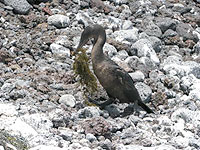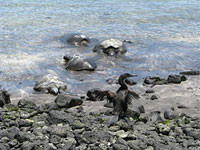

 | |||||||||||||||
|
|
Journals 2008/2009Tom Bogard
September 6, 2008 I woke up today to an absolutely incredible scene and great weather. We had anchored earlier that night in a protected area in the shadow of the volcano Serro Azul. The volcano had a very mysterious feel to it. The top was shrouded in clouds and you could see the overlapping paths of the different lava flows along the flanks. There were numerous spatter cones on the flank and the lava plane at the base of the mountain. The coastline was very rough, jagged, and rocky. Without any man-made structures it was difficult to get a sense of scale of the whole view. This is what I had imagined the Galapagos Islands to be like: beautiful, remote, pristine, and exotic. The realization of where I actually was and the stark beauty of the landscape were overpowering. Words can never adequately convey the beauty and grandeur of the islands. Right after breakfast we suited up and got into the panga for the day's survey. The morning's work was all done from the sea in the panga. We called off the species counts, which were then recorded into the GPS and survey form. After lunch on the boat we set out for a small cove and got out of the panga to survey and to check PIT tags on Galapagos Flightless Cormorants. PIT tags (passive integrated transponder tags) are small microchips, about the size of a grain of rice, that are injected into an animal. Researchers use hand-held scanners to detect PIT tags in Cormorants that had been previously captured and injected with the tags. The scanner read the tag's electromagnetic code and displayed the tag's number. Scanning Cormorants for PIT tags allows the scientists to identify and track the birds. The sensor to read the tags was mounted on the end of a pole with the readout on the opposite end. To read the tag the sensor end of the pole was placed under a Cormorant usually while it was on the nest and the number, if there was a tag, was read and recorded. This data would later be analyzed. The Galapagos Flightless Cormorant is not an attractive bird. As they evolved on the islands separated from other Cormorants they have lost the ability to fly. They have short, stubby vestigial wings and are exceptionally vocal (a not so pleasant squawking sound) as you approach them and will snap at you if you get too close to their nest. In contrast, they have beautiful blue eyes. Their nests are constructed of material that was gathered up by the male and offered to the female who builds the nest. These materials could be bits of seaweed, trash, or anything else the male finds at sea (we even saw a pair of underwear as part of one of the nests!). The males present the material to the female who can either accept it and use it or reject it and toss it aside. The nesting areas were stained a brilliant white from all of the accumulated droppings and had a pungent odor. While on shore I saw four Green Sea Turtles basking in the sun on the rocky beach. They were beautiful animals that allowed me to get within a meter of them before they even stirred from their basking. One turtle had several crabs on it that appeared to be cleaning the turtle of unwanted organisms. There were several more turtles in the cove. They swam with grace and ease; it was amazing to watch them. Another organism that we looked for and counted were feral cats. These cats are descended from pet cats that had been released or escaped. As an introduced species they have proven to be a large problem to native animals and difficult to eradicate. The feral cats prey upon the eggs of ground nesting birds, such as Galapagos Penguin and Flightless Cormorant, and their young. Today we counted two cats. These cats were the most horrible, emaciated cats that I have ever seen. It is a wonder that they have survived and reproduced in such a harsh environment. The trip back to the Queen Mabel was eventful. Just as we cleared the cove we saw a very large Manta Ray flying smoothly and gracefully through the water. Very cool! After dinner in the main cabin the computers were brought out and the day's data was recorded and given a preliminary analysis. This would be the standard procedure for each night of the survey. Because of my limited knowledge of Spanish I could not participate in this aspect of the Survey.
|
||||||||||||||


